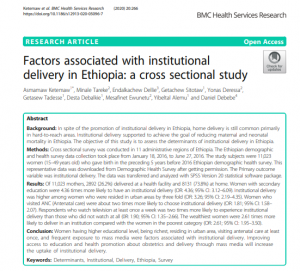
Background
In spite of the promotion of institutional delivery in Ethiopia, home delivery is still common primarily in hard-to-reach areas. Institutional delivery supported to achieve the goal of reducing maternal and neonatal mortality in Ethiopia. The objective of this study is to assess the determinants of institutional delivery in Ethiopia.
Methods
Cross sectional survey was conducted in 11 administrative regions of Ethiopia. The Ethiopian demographic and health survey data collection took place from January 18, 2016, to June 27, 2016. The study subjects were 11,023 women (15–49 years old) who gave birth in the preceding 5 years before 2016 Ethiopian demographic health survey. This representative data was downloaded from Demographic Health Survey after getting permission. The Primary outcome variable was institutional delivery. The data was transferred and analyzed with SPSS Version 20 statistical software package.
Results
Of 11,023 mothers, 2892 (26.2%) delivered at a health facility and 8131 (73.8%) at home. Women with secondary education were 4.36 times more likely to have an institutional delivery (OR: 4.36; 95% CI: 3.12–6.09). Institutional delivery was higher among women who were resided in urban areas by three fold (OR: 3.26; 95% CI: 2.19–4.35). Women who visited ANC (Antenatal care) were about two times more likely to choose institutional delivery (OR: 1.81; 95% CI: 1.58–2.07). Respondents who watch television at least once a week was two times more likely to experience institutional delivery than those who did not watch at all (0R: 1.90; 95% CI: 1.35–2.66). The wealthiest women were 2.61 times more likely to deliver in an institution compared with the women in the poorest category (OR: 2.61; 95% CI: 1.95–3.50).
Conclusion
Women having higher educational level, being richest, residing in urban area, visiting antenatal care at least once, and frequent exposure to mass media were factors associated with institutional delivery. Improving access to education and health promotion about obstetrics and delivery through mass media will increase the uptake of institutional delivery.